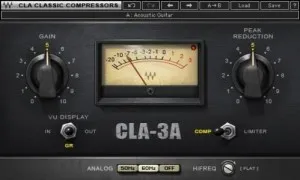What's The Point Of Compression In Your Mix?
Mar 21, 2014Everyone loves to talk about how awesome compression is, but it’s also ruined so many mixes. So what’s the deal with compression? Should you be using it in your mixes? If so, why? And how?

Following on the heels or our discussion of EQ, today I want to share the simple truth about compression.
Automatic Fader Control
Compression was actually invented to stop stuff from blowing up. Well, more correctly it was used as a way to protect electronic equipment and tape from overloading. Think about it, audio is very dynamic. A snare drum, a rock singer, an acoustic guitar: all of these can go from whisper quiet to all out ear drum blast in a second.
Before compressors were invented, an engineer literally had to hand ride volume faders to control the signal level before it hit tape, every single time. How annoying this must of been!
Someone got smart, and created a device that could “look at” the audio signal coming in, determine if it was an acceptable level (i.e. below the threshold) or too loud of a signal (above the threshold) and then quickly turn it down. No humans needed.
This amazing process is, in my opinion, the best reason to use compression: to automatically control the volume of your tracks. With just a little bit of compression here and there, you can effectively contain your audio as needed, giving you control and polish, without the fear of a random spike in audio or a massive dip in volume, both of which are distracting to listeners.
Instant Energy
Ironically a compressor is one of the best ways to bring energy and excitement to your tracks. By setting what’s called a slow attack, you can help turn up the quieter parts of the track, while containing the louder parts of the track, all without killing the transient. The result? More energy.
I do this with acoustic guitars and vocals all the time. The little strums or words that dip down in volume a bit are then matched to the louder ones and what you notice is more excitement in the audio. Things seem a bit more in your face, while still being controlled.
Tone And Sustain
Two more cool things you can do with compression involve tone and sustain. Believe it or not, compressors can have sonic characteristics that impart a certain frequency response to your audio. Hence, they are instant tone machines. That’s why three different compressors with the exact same settings can give your lead vocal totally different tones.
They also can be used to squeeze out more sustain. By clamping down on transients, and using the makeup gain feature to turn up the remaining tail of the note, you create the illusion of having more sustain. This is great for fat snare drums or bass guitars.
Use Only As Needed
As with EQ, compression should be used only as needed in a mix. That might mean a lot of compression, which is totally fine, just only use it when you know why you are using it. Otherwise leave it alone and go back to the fundamental question when mixing: do these tracks sound balanced to me?
Discover The 6 Steps for Creating a
Radio-Ready Song from Scratch"
Enter Your Email Below To Receive The Free 17-page PDF,
"6 Steps To A Radio-Ready Song"
We hate SPAM. We will never sell your information, for any reason.

